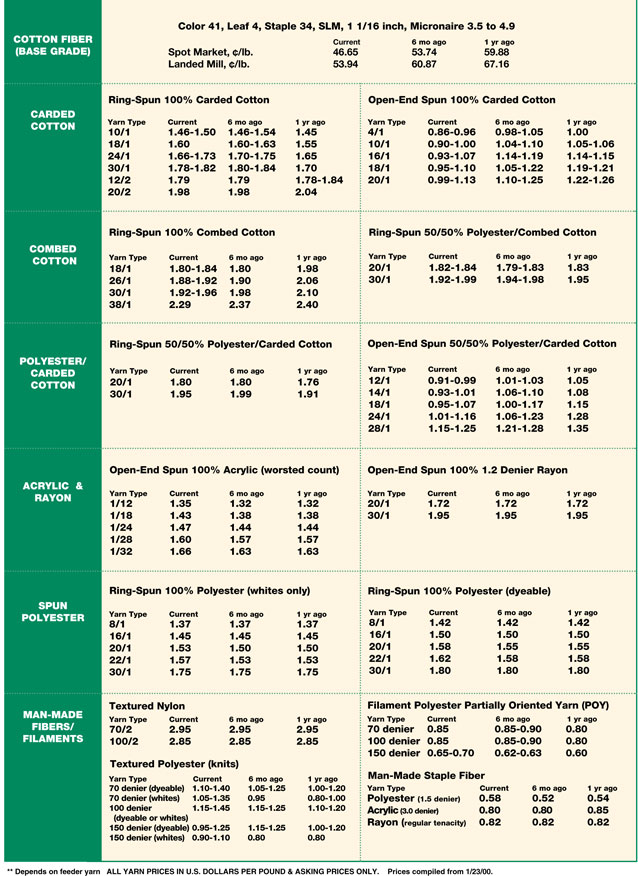T
alking with texturizers is a lot like talking with cotton spinners because they are both
experiencing much the same problems — increasing costs, cheap imported yarn and garments, customer
resistance to price increases and long-term contracts.
One texturizer responded to this month’s Yarn Market by saying: “Apparel markets are
especially soft but the upholstery markets are OK. Automotive markets are pretty good as well.
Basically, we are running full and we are sold up with some bookings as far as five months ahead.”
He added: “There will be a selective jump in the price we pay for certain polyester fibers in
April with an across-the-board increase in July. Volume-wise I feel this will be a pretty good year
— stronger than last year — but we will continue to have problems with our margins. Pricing is
terrible. Not as bad as for open-end yarns, but terrible.” The problem will be passing on the
increase in raw material costs to the customer.
Markets for POY yarns are reported as “pretty good,” but they are very flat. Here again it is
difficult for the texturizer to get prices up even enough to get back the recent increase in these
feed yarns. The customer resistance is due mainly to the influx of cheap imports, according to this
respondent.
Good For Business
Cotton spinners vary in their appraisal of market conditions, with comments ranging from “
business is improving” to “excellent.” Figure it out.
Ring-spun yarns continue to move well. Several spinners of both ring spun and air jet rated
their markets for these yarns as excellent.
One such spinner said: “All of the indicators point to a pretty good year. Prices are at
least competitive, our customer confidence is high and the Asian problems have subsided. This
should be good for business.”
This spinner reports that they are running a full seven-day schedule. He also predicts that
open-end yarns, the markets for which he reports as “steady — nothing to write home about but OK,”
will be stronger within the next 4 to 6 weeks.
Another spinner said: “All of our markets are excellent, very active, very strong. But we are
in a most competitive environment, an environment where we are making money but we are not really
profitable.
“All of our indirect expenses have gone up like wages, insurance, cardboard boxes, yarn cones
and on and on. The only thing that is somewhat lower in price is cotton and even that is on the way
up. We are quite fortunate in that we were recently able to increase prices. But that has been
tough.” So what do you do? As this spinner says: “You keep trying.”
One cotton respondent said: “We haven’t yet regained the momentum in sales volume we
experienced just before Christmas but we’re close to the start of the regular season. We expect a
turn-around soon. Our volume is good, but pricing is terrible.”
The spinners who report excellent sales positions have a worry that any manufacturing
operation would like to have. They worry about making enough yarn to fill orders.
At this particular time spinners in the South are being plagued by inclement weather. It is
difficult to make a product when your employees can’t get to work.
Fact Or Fable
One of the respondents this month, a cotton spinner making open-end yarns, was quite concerned
with a rumor circulating that a new open-end facility was planned for construction. According to
this spinner the operation is planned by a vertical manufacturer.
With respect to this rumor, he said: “I really cannot imagine building a new operation of
this type when everyone knows of the oversupply of open-end yarn existing today. Most mills realize
that OE yarn can be bought for less than it costs to make so why build a mill?”
He also discussed how additional production would affect sales and prices. The only possible
positive effect this could have would be to discourage imported yarn. As a spinner said last month:
“The reason prices are stabilizing is that they are so low that the industry can’t go any lower.”
These low prices discourage imports as well because it doesn’t allow any margin for them
either.

March 2000




